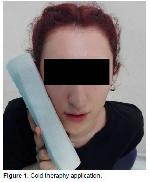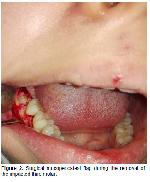Third molar surgery can cause pain, swelling, and trismus due to the trauma that occurs in soft tissues and bone structures in the oral cavity
1. Cold therapy is recommended at the site to prevent these postoperative complications. It is the simplest and oldest method of treating tissue damage caused by surgery, having been used since the time of Hippocrates
1,3. However, recent researchers have raised doubts about whether cold therapy has an effect.
Researchers assumed that the beneficial effects of cold treatment are derived from various physiological processes, such as decreased enzyme activity, reduced blood flow with vasoconstriction, restricting the extravasation of blood to surrounding tissues, reducing edema and inflammation, deceleration of tissue metabolism, and reduction of nerve conduction48. Courage and Huebsch9 reported that the application of cold therapy after third molar extraction effectively reduced pain and swelling. Similarly, in their study on patients who had a bilaterally impacted third molar, 10.
Laureano Filho et al.10 showed that cold therapy reduced serious side effects, such as postoperative pain and swelling. However, they reported that cold therapy did not affect trismus. They further observed that the reduction in pain on the side treated with cold therapy may be related to psychological factors as the patient is aware of which side surgery was performed and cold therapy applied. Forouzanfar et al.11 showed that compression (with or without cold therapy) was a good method of treating patients following impacted third molar surgery. They reported that ice application controls inflammation and bleeding. In addition, they argued that compression with ice reduces the excitability of free nerve endings and peripheral nerve fibers, thereby raising the pain threshold. This result is the outcome of any dermal stimulation resulting from compression, which stimulates A-beta fibers1115. However, whether the reduction in pain is due to cold therapy or compression is unclear. Compression alone and compression with cold therapy can produce similar results, as partially explained by a vasoconstrictive effect. This effect occurred in Forouzanfar et al.11s study A-beta fibers owing to the compression of force applied to the tissue, which in turn compressed the vascular system feeding the area. As a result, blood flow to that area decreased. They hypothesized that decreased blood flow in the surgical field will decrease the flow of inflammatory and pain receptors. The placebo effect on pain of compression and ice compression therapy methods is not clear. In the late 1970s, Levine et al. noted that placebo analgesia is a result of endorphin production in the CNS13 and that the placebo effect on the operative side may result in the release of endorphins. Hence, compression or ice compression is administered based on the assumption that the placebo effect is equal in both treatment methods and that the same physiological processes reduce pain16. Bastian et al. explained that the successful application of ice after impacted third molar surgery to help reduce pain and muscle spasm, as well as swelling and inflammation, was attributable to its vasoconstrictive effect. They also stated that this reduction in pain was probably due to a combination of the modified inflammatory response, which consisted of freezing, and the extinction of peripheral nerve endings17. In a study examining the effect of cold therapy after impacted tooth surgery, Ibunkle et al. reported that the subjects reported less postoperative pain, swelling, and difficulty in opening the mouth, thus leading to a better quality of life compared with subjects not using cold therapy. The perception of reduced pain intensity observed among the subjects receiving cold therapy may be due to the direct effect of cold therapy on nerve conduction and inflammation. Cold therapy raises the threshold of pain fibers and decreases the rate of nerve conduction5. When the limited results of this study were evaluated, statistically significantly less pain was experienced in the patient group that applied cold therapy on the 2nd postoperative day, compared with the control group.
Certain studies indicate that cold therapy is an inexpensive, harmless, and effective method of treating pain and swelling, whereas other studies find its ineffectiveness. Among these, Van der Westhuijzen et al. did not find a statistically significant benefit for patients who received cold therapy compared with those who did not, in terms of pain, swelling, and trismus in the first 24 hours after third molar extraction and low-dose analgesic/anti-inflammatory treatment. They also reported that uninterrupted cold therapy for 15 minutes and longer may cause tissue death due to prolonged vasoconstriction, ischemia, and capillary thrombosis. Because of the large vascular network in the oral and maxillofacial areas, these adverse effects have a low likelihood of occurring, but the possibility should not be ignored4. The present study has shown that cold therapy may reduce pain on the 2nd day. However, when the data obtained from the patients on other days were evaluated, no statistically significant difference could be detected between the control and treatment groups. Consistent with Forsgren et al.18 and Zandi et al.1, the present investigation did not show useful effects of cold therapy on pain, swelling, and trismus postoperatively. The ineffectiveness of cold therapy may have three explanations. First, a cold application on the skin does not reduce the temperature in deep tissues. Cold experienced in the buccal fat pad in the subcutaneous tissues and high vascularization in the facial area does not pass into the deep tissues. Second, the analgesic/anti-inflammatory drugs taken by the patient mask the possible positive effects of cold application. Third, the ineffectiveness is due to the possible placebo effect shown in studies where cold application has a positive effect1,4,18.
In conclusion, cold therapy is a simple and affordable treatment frequently ordered by oral and maxillofacial surgeons and dentists to reduce pain, swelling, and trismus after dentoalveolar surgeries. This study has shown that cold therapy reduces pain on postoperative day 2 only and has no effect at any other time or on trismus and swelling. We conclude that the benefit of cold application is still doubtful; thus, further studies are required to resolve conflicting results.
Conflict of Interest: The authors declerate there is no conflict of interest.
Funding: There is no funding.






